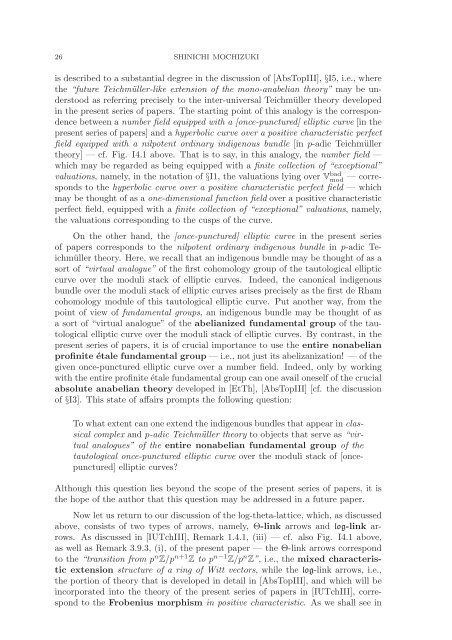Inter-universal Teichmuller Theory I: Construction of Hodge Theaters
Inter-universal Teichmuller Theory I: Construction of Hodge Theaters
Inter-universal Teichmuller Theory I: Construction of Hodge Theaters
Create successful ePaper yourself
Turn your PDF publications into a flip-book with our unique Google optimized e-Paper software.
26 SHINICHI MOCHIZUKI<br />
is described to a substantial degree in the discussion <strong>of</strong> [AbsTopIII], §I5, i.e., where<br />
the “future Teichmüller-like extension <strong>of</strong> the mono-anabelian theory” may be understood<br />
as referring precisely to the inter-<strong>universal</strong> Teichmüller theory developed<br />
in the present series <strong>of</strong> papers. The starting point <strong>of</strong> this analogy is the correspondence<br />
between a number field equipped with a [once-punctured] elliptic curve [in the<br />
present series <strong>of</strong> papers] and a hyperbolic curve over a positive characteristic perfect<br />
field equipped with a nilpotent ordinary indigenous bundle [in p-adic Teichmüller<br />
theory] — cf. Fig. I4.1 above. That is to say, in this analogy, the number field —<br />
which may be regarded as being equipped with a finite collection <strong>of</strong> “exceptional”<br />
valuations, namely, in the notation <strong>of</strong> §I1, the valuations lying over V bad<br />
mod — corresponds<br />
to the hyperbolic curve over a positive characteristic perfect field —which<br />
may be thought <strong>of</strong> as a one-dimensional function field over a positive characteristic<br />
perfect field, equipped with a finite collection <strong>of</strong> “exceptional” valuations, namely,<br />
the valuations corresponding to the cusps <strong>of</strong> the curve.<br />
On the other hand, the [once-punctured] elliptic curve in the present series<br />
<strong>of</strong> papers corresponds to the nilpotent ordinary indigenous bundle in p-adic Teichmüller<br />
theory. Here, we recall that an indigenous bundle may be thought <strong>of</strong> as a<br />
sort <strong>of</strong> “virtual analogue” <strong>of</strong> the first cohomology group <strong>of</strong> the tautological elliptic<br />
curve over the moduli stack <strong>of</strong> elliptic curves. Indeed, the canonical indigenous<br />
bundle over the moduli stack <strong>of</strong> elliptic curves arises precisely as the first de Rham<br />
cohomology module <strong>of</strong> this tautological elliptic curve. Put another way, from the<br />
point <strong>of</strong> view <strong>of</strong> fundamental groups, an indigenous bundle may be thought <strong>of</strong> as<br />
a sort <strong>of</strong> “virtual analogue” <strong>of</strong> the abelianized fundamental group <strong>of</strong> the tautological<br />
elliptic curve over the moduli stack <strong>of</strong> elliptic curves. By contrast, in the<br />
present series <strong>of</strong> papers, it is <strong>of</strong> crucial importance to use the entire nonabelian<br />
pr<strong>of</strong>inite étale fundamental group — i.e., not just its abelizanization! — <strong>of</strong> the<br />
given once-punctured elliptic curve over a number field. Indeed, only by working<br />
with the entire pr<strong>of</strong>inite étale fundamental group can one avail oneself <strong>of</strong> the crucial<br />
absolute anabelian theory developed in [EtTh], [AbsTopIII] [cf. the discussion<br />
<strong>of</strong> §I3]. This state <strong>of</strong> affairs prompts the following question:<br />
To what extent can one extend the indigenous bundles that appear in classical<br />
complex and p-adic Teichmüller theory to objects that serve as “virtual<br />
analogues” <strong>of</strong> the entire nonabelian fundamental group <strong>of</strong> the<br />
tautological once-punctured elliptic curve over the moduli stack <strong>of</strong> [oncepunctured]<br />
elliptic curves?<br />
Although this question lies beyond the scope <strong>of</strong> the present series <strong>of</strong> papers, it is<br />
the hope <strong>of</strong> the author that this question may be addressed in a future paper.<br />
Now let us return to our discussion <strong>of</strong> the log-theta-lattice, which, as discussed<br />
above, consists <strong>of</strong> two types <strong>of</strong> arrows, namely, Θ-link arrows and log-link arrows.<br />
As discussed in [IUTchIII], Remark 1.4.1, (iii) — cf. also Fig. I4.1 above,<br />
as well as Remark 3.9.3, (i), <strong>of</strong> the present paper — the Θ-link arrows correspond<br />
to the “transition from p n Z/p n+1 Z to p n−1 Z/p n Z”, i.e., the mixed characteristic<br />
extension structure <strong>of</strong> a ring <strong>of</strong> Witt vectors, while the log-link arrows, i.e.,<br />
the portion <strong>of</strong> theory that is developed in detail in [AbsTopIII], and which will be<br />
incorporated into the theory <strong>of</strong> the present series <strong>of</strong> papers in [IUTchIII], correspond<br />
to the Frobenius morphism in positive characteristic. As we shall see in
















